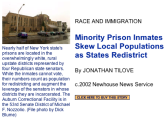Fixing prison-based gerrymandering after the 2010 Census: Florida
50 State Guide, March 2010
- Sections
- Impact at the state level
- Impact at the local level
- Pending legislation
- Other solutions
- Additional resources
Prison-based gerrymandering violates the constitutional principle of “One Person, One Vote.” The Supreme Court requires districts to be based on equal population in order to give each resident the same access to government. But a longstanding flaw in the Census counts incarcerated people as residents of the prison location, even though they can’t vote and aren’t a part of the surrounding community.
When legislators claim people incarcerated in their districts are legitimate constituents, they award people who live close to the prison more of a say in government than everybody else.
Impact at the state level:
- After the 2000 Census:
- More than 7% of House Districts 10 and 12 was incarcerated disenfranchised people from other parts of the state, giving each group of 93 actual residents of this district as much influence as 100 residents in other districts that do not contain prisons.
- More than 6% of House District 5 was incarcerated disenfranchised people from other parts of the state, giving each group of 94 actual residents of this district as much influence as 100 residents in other districts that do not contain prisons.
- Almost 5% of House District 7 was incarcerated disenfranchised people from other parts of the state, giving each group of 95 actual residents of this district as much influence as 100 residents in other districts that do not contain prisons.
Impact at the local level:
- After the 2000 Census:
- Faced with drawing skewed districts based on unadjusted Census data, County Commission members in Gulf County, drew districts that did not include the prison populations. The Florida Attorney General had issued an opinion stating that the county must include prison populations when drawing their county districts, but the county ignored this advice in favor of drawing districts based on the Constitutional and democratic principle of “one person, one vote.” Columbia, Hamilton, Holmes, and Madison counties also rejected prison-based gerrymandering and base their county districts on actual residents instead of prison populations.
- In Baker County, 25% of the people in District 1 were incarcerated in a correctional facility, not residents of the county. As a result, each group of 75 actual residents in District 1 was given as much political clout as 100 people elsewhere in the county.
- In Calhoun County, 48% of the people in District 4 were incarcerated at the Calhoun Correctional Institution. As a result, the actual residents of District 4 were given almost twice as much political clout as people elsewhere in the county.
- In Hardee county, 20% of the people in District 2 were incarcerated in a correctional facility, not residents of the county. As a result, each group of 80 actual residents in District 2 was given as much political clout as 100 people elsewhere in the county.
- In Jefferson County, 29% of the people in District 3 were incarcerated in a correctional facility, not residents of the county. As a result, each group of 71 residents in District 3 was given as much political clout as 100 people elsewhere in the county.
- In Wakulla county, 18% of the people in District 1 were incarcerated in a correctional facility, not residents of the county. As a result, each group of 82 actual residents in District 1 was given as much political clout as 100 people elsewhere in the county.
- More research needs to be done, especially in the following counties: Bradford, DeSoto, Dixie, Franklin, Jackson, Lafayette, Sumter, Taylor, Union, and Washington and the city of Bartow. (These communities contain large prisons relative to their actual population.) Unless the prison populations were removed from the redistricting base after the Census, if these communities have districts, they will have one or more districts that are significantly padded with non-resident prison populations. See the Democracy Toolkit for a suggested research methodology.
Pending legislation (as of March 2010):
- A bill in the State Senate (S1386) was introduced by Senator Bullard on January 26, 2010. The bill “Requires the Legislature to adjust federal decennial census figures to include prisoners in the geographic areas where they last resided before incarceration rather than the facility where they were residing at the time of the federal census.”
Other solutions:
- Other counties should follow Gulf County’s solution of drawing county districts based on actual populations, refusing to pad some districts with prison populations.
- Ideally, the U.S. Census Bureau would change where it counts incarcerated people. They should be counted as residents of their home — not prison — addresses. There is no time for that in 2010, but Florida should ask the Census Bureau for this change for 2020.
Additional resources:
 Minority Prison Inmates Skew Local Populations as States Redistrict by Jonathan Tilove, Newhouse News Service, March 12, 2002
Minority Prison Inmates Skew Local Populations as States Redistrict by Jonathan Tilove, Newhouse News Service, March 12, 2002- State officials tell counties to exclude prison populations from county level redistricting by Peter Wagner, November 1, 2004 (about the Florida exception to the rule)
- Fear of “unwieldy” rural districts in Florida should not have led to dilution of one person one vote principle, by Peter Wagner, January 26, 2004
- Prison-Based Gerrymandering in Florida Counties [PDF] Prison Policy Initiative. December, 2010.
- A list of new large prisons built in Florida since the 2000 Census. These prisons are likely to create new prison-based gerrymandering problems after their populations are counted in the 2010 census.
 Minority Prison Inmates Skew Local Populations as States Redistrict
Minority Prison Inmates Skew Local Populations as States Redistrict


